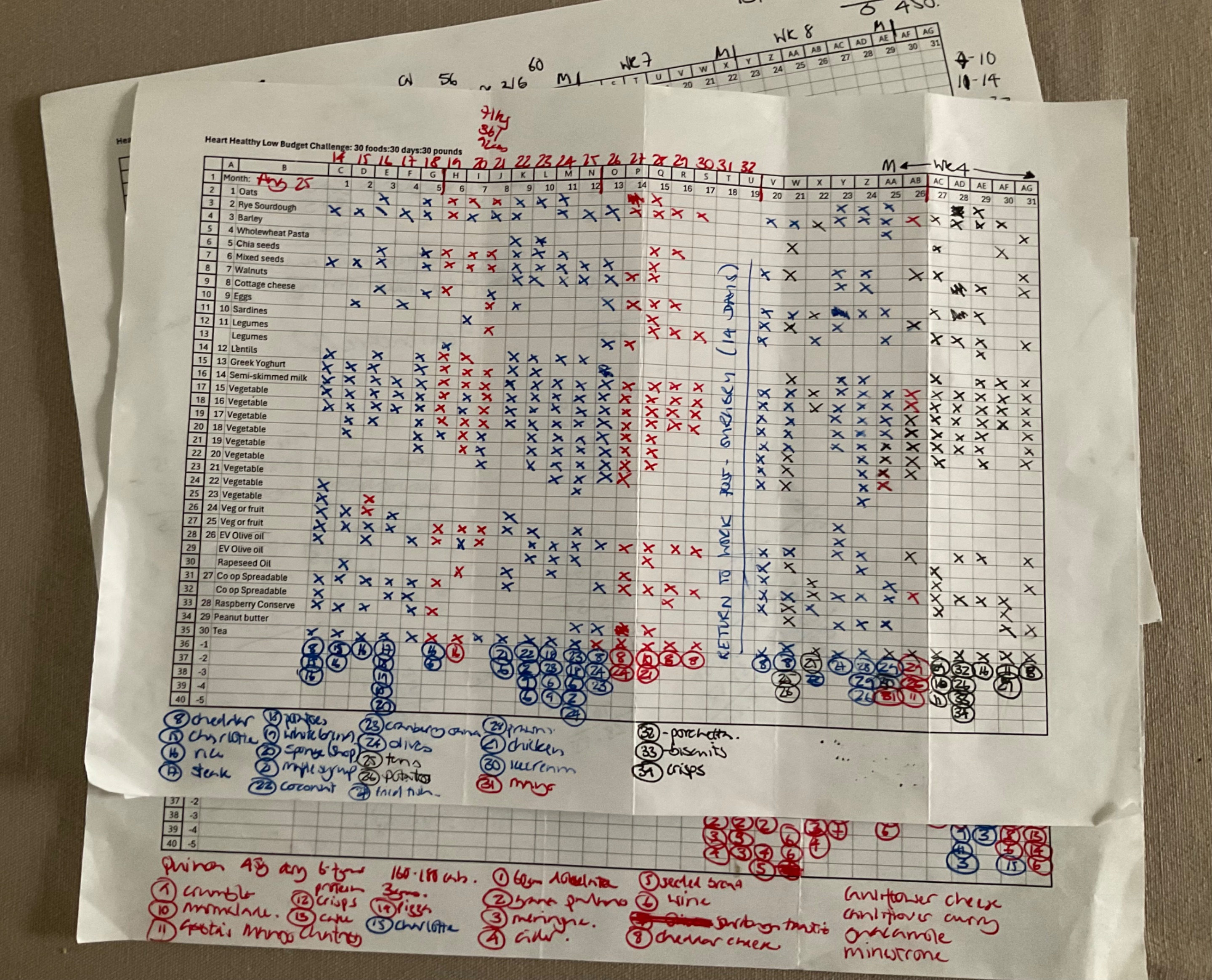
My easy, couple of minutes a day max, food logging system.

I went for a heart healthy no buy month based on the Mediterranean diet and with £30 a week food shopping budget leading to the 30 days, 30 foods, 30 pounds challenge.
I enjoy gentle no-buy challenges, it's an opportunity for a review and reset. This time round I wanted clear my pantry of half opened packets and jars of things I bought thinking they would be useful. I have a bigger ambition of improved cholesterol results at my next set of tests around 21 October.
You can read the journey here: Can I do a heart healthy no-buy month? Two weeks in Week three - are the stars aligning?
I created a simple spreadsheet to log my foods, a month to a single side of A4. It had my 30 foods, a mix of categories and specific foods, plus five flex lines for foods that fell outside my thirty foods - things like Parmesan, meringue nests etc - and was easy to complete in a minute or two each day.
I kept going after the original thirty days and I'm now up to sixty three days or nine weeks.

Results
1. Food choices
The thirty foods were a great basis for my plan, and cut down a lot of the noise around shopping.I didn't have to buy anything exotic, and there was plenty of room for variation in the categories and flex lines. I've cleared two shelves in my pantry, there's still a collection of flours and, for some reason, desiccated and flaked coconut. I'll get round to those over time. Barley didn't get much of a look-in, it takes quite a long time to cook and I often didn't think about it until too late.
2. Nutrition
The biggest change here was increasing protein from 75g to 85g a day, and generally bumping up the amount of protein I'm eating. Otherwise, I'm hitting the 45g fibre and recommended daily intake for omega-3s. It looks like I'm settling into two main meals a day with a snack in between.
3. Savings
I spent £30 a week for the first two weeks, then I was offered some discounts and for the next three weeks bought what I needed for fifteen pounds, giving savings of forty-five pounds. My local retailer has Fridge Filler Mondays with 50+ everyday items at 50% off, plus another 50+ items price matched with the cheapest retailer (Aldi). I moved my shopping day to Mondays and have continued to spend around about fifteen pounds a week on food.
30 days: budget £128, spend £64, savings £64. 63 days: budget £270, spend £165, savings £105.

Lessons Learned
1. Protein is your friend!
Upping my protein has really made a difference. Meals are more satisfying and a hard boiled egg is great for an after meal snack or mid-morning hunger.
2. Nutrient dense and calorie poor!
Every now and then I spot check a day's menu for protein, fibre and omega-3s - all coming up trumps and often with a small calorie deficit.
3. Keep out of shops!
I knew that going into shops was my downfall, and this challenge emphasised it. I'm great at being disciplined at online shopping, but cross the threshold of any retailer and I'm taken in by all the shiny things!
4. Do you need a freezer?
I don't have a freezer at present, or an ice-box in the top of my fridge. I've found I can manage without. I'm not a big fan of batch cooking either. I'll make something that I'll eat over two to four days, alternating with other foods, and I keep cans and microwave pouches for those busy days.
I like expensive tea and coffee and I was able to get those within my budget.

Cholesterol
The UK has a primary prevention policy for reducing cardiovascular events that includes the use of statins for people with a QRISK3 score of 10% or more of a CVD event within the next ten years if other conditions like elevated LDL are present.
Statins are comparatively low-cost (although cumulatively big business) at approximately £40 per person in the first year and about £25 per person in subsequent years. They are easily administered through the primary care (eg GP surgeries) network, and monitoring can be done through routine blood tests for cholesterol.
The policy advocates supporting lifestyle changes initially and any discussions and prescribing of statins made in partnership with the patient. On enquiry, I was told that there is no support locally for lifestyle changes other than what is available online at the NHS website, but this may vary according to region.
Very broadly, lifestyle interventions, even when available, cost an average of £600 per person and are more difficult to administer, although improvements in cholesterol can still be tracked through routine blood tests. Being able to make lifestyle changes may depend on an individual's personal circumstances.
The relative risk reduction for statins can range from 25%-30% (ie the reduction from a QRISK3 score of 15% to 11%). However, the absolute risk reduction is much lower (4% in the example given), and absolute risk reduction through lifestyle changes are often similar or slightly better than statins, depending on the individual.
An average direct cost to the NHS of a CVD event is about £7,000, so the potential to reduce that by 4% could lead to substantial savings. For a city the size of Leicester that could be something like £64.0 million over ten years.
Primary care contracts with the NHS include KPIs for the numbers of relevant people (ie fall in the risk category) who are prescribed statins. There is an opt out field for people who decline medication, which prevents funding being reduced for not meeting the CVD primary prevention KPIs.
I have chosen to decline statin medication at present and requested quarterly blood tests over twelve months to monitor the impact of lifestyle changes.
My feeling overall is that there is a lot we don't know about the effects of life-time statin medication, some of the evidence is inconclusive and the QRISK3 score is about probability, not forecast.
This is a personal decision: everyone is different and will have different considerations and circumstances that affect whether they decide, in discussion with their healthcare provider, to take statins.




